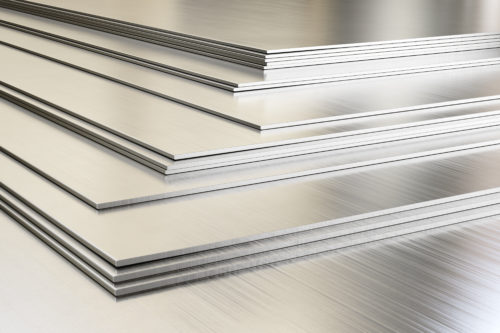Both stainless steel and galvanized steel are strong and durable, but each one has specific advantages, depending on the application. When it comes to galvanized steel vs. stainless steel, you have to understand the difference between the two and consider what type of product you’re making and what demands it will face in its environment. From there, the best choice for you will become clear.
What Is Galvanized Steel vs. Stainless Steel?

Galvanized steel is coated with zinc to protect it from rust, while stainless steel is an alloy made with at least 10% chromium for the same reason: to guard against rust and corrosion. There are several types of stainless steel, each determined by the type and amount of additional materials, like chromium, as well as nickel, titanium, manganese, and/or molybdenum, present in the steel:
- Austenitic stainless steel
- Ferritic stainless steel
- Long-wearing martensitic steel
- Duplex stainless steel
- Precipitation-hardening stainless steel
Benefits & Drawbacks of Galvanized Steel vs. Stainless Steel
The strengths and weaknesses of each type of steel will help you determine whether it’s right for your application:
Galvanized Steel
 Galvanized steel is water-resistant, but it does not hold up well under salt water. When compared to stainless steel, it’s easier to work with and much less expensive. For many construction applications, galvanized steel is a trusted, economical choice, as long as it won’t be in contact with salt water.
Galvanized steel is water-resistant, but it does not hold up well under salt water. When compared to stainless steel, it’s easier to work with and much less expensive. For many construction applications, galvanized steel is a trusted, economical choice, as long as it won’t be in contact with salt water.
However, one drawback is in the welding process: the zinc coating releases toxic fumes that can contribute to flu-like symptoms and discomfort, so it’s important for welders to have the proper protective equipment. Because welding removes the zinc in the welding area, that area is subject to corrosion. In many situations, it may be preferable to galvanize the steel after the welding process is complete.
Stainless Steel
 Exceptionally strong and rust-resistant, stainless steel withstands contact with both fresh and salt water—but not chlorinated water, which will cause the steel to degrade quickly. It offers more corrosion resistance than galvanized steel, making it a great choice for marine and aerospace applications.
Exceptionally strong and rust-resistant, stainless steel withstands contact with both fresh and salt water—but not chlorinated water, which will cause the steel to degrade quickly. It offers more corrosion resistance than galvanized steel, making it a great choice for marine and aerospace applications.
One major drawback is the cost: stainless steel can be about five times more expensive than galvanized steel. It also requires highly skilled welders with exceptional patience and control. Further, stainless steel can weld itself together if two pieces are in contact and the friction rubs through the coating, which could be a concern in certain applications.
Applications of Galvanized Steel vs. Stainless Steel
Hinges, gaskets, and fasteners like nuts, bolts, screws, and nails are often made of galvanized steel to withstand extreme weather conditions. In high-moisture environments, like automobile exhaust pipes, marine applications, and the aerospace industry, stainless steel is typically the best choice.
Choosing between galvanized and stainless steel comes down to your application. For example, galvanized steel is not effective in marine applications. In that situation, stainless steel is essential.
However, in most circumstances, galvanized steel is going to be the more economical option. Materials and labor are both more affordable, and you can still depend on galvanized steel’s strength and long service life.
At Metal Craft Spinning & Stamping, we’ve been producing high-quality products for our clients for nearly 60 years. As a fourth-generation family-operated company, we’re committed to building long-term, trusted relationships with our clients by providing on-time delivery, a collaborative process, and a personalized approach to every project. Request a quote today, or contact us to learn more about our products and services and whether galvanized steel or stainless steel is best for your project.



